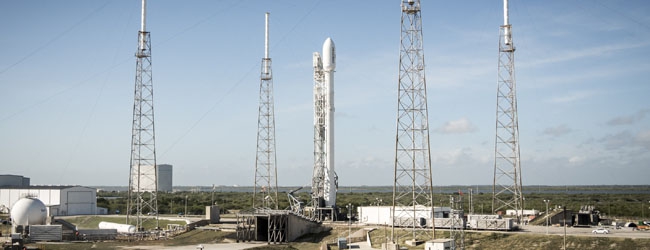
Features
Business
Management
A Return to Industrialism
September 6, 2016 By Jon Robinson
 SpaceX is the world’s fastest-growing provider of launch services with more than 70 launches on its manifest, representing more than $10 billion in contracts, including a $1.6 billion contract with NASA for 12 cargo resupply missions to the International Space Station. (Photo courtesy SpaceX)
SpaceX is the world’s fastest-growing provider of launch services with more than 70 launches on its manifest, representing more than $10 billion in contracts, including a $1.6 billion contract with NASA for 12 cargo resupply missions to the International Space Station. (Photo courtesy SpaceX) When the term Web 2.0 seeped into business vernacular in the mid-2000s, it seemed to hold little concrete meaning. It was Internet ether following crazed venture capital funding of nascent but often flawed online business strategies. Web 2.0 initially seemed like a make-good promise for millions of lost dollars.
In hindsight, Web 2.0 is now the descriptor for the foundation of user-generated content manifested most obviously as billion-dollar social media platforms. It has created completely new businesses amassing enormous wealth – in a matter of years as opposed to decades – as younger generations successfully tap into a robust online economy.
Industry 4.0 is a much more relevant evolutionary term for the printing industry. Unlike Web 2.0, which certainly drove the Internet to become a GDP factor, Industry 4.0 ultimately involves the deployment of tangible goods, factories, machines and equipment.
The Internet of Things is an important business term to understand, but perhaps more of an acknowledgement for the revolutionary – existing – network infrastructure built by the likes of Cisco, Sun and Oracle. Industry 4.0, which includes The Internet of Things amid its most prevailing and complicated definitions, is a term to describe the new wealth to be generated from an overdue return to industrialism.
For more than 50 years, the greatest business innovations to emerge out of stable economies have been generated around computing, from software and graphical user interfaces to processor chips and communications networks (both micro and macro). As Moore’s Law reaches its limit, which Intel’s CEO stated to be a reality in 2015, Industry 4.0 arrives for business visionaries to begin leveraging decades of computing power to drive industrial equipment.
Elon Musk, who was born in South Africa but also holds Canadian and American citizenships, is the ultimate Industry 4.0 visionary. In 1995, Musk and his brother, Kimbal, used a small family loan to start Zip2 and develop online city guides for newspaper publishers, leading to contracts with The New York Times and Chicago Tribune.
In 1999, Compaq acquired Zip2 for $307 million in cash and, within weeks, Musk’s proceeds co-founded an Internet-based financial services company called X.com. A year later, X.com merged with Confinity, which held a money transfer service called PayPal. Musk was PayPal’s largest shareholder when eBay bought it for $1.5 billion in 2002. Within weeks, Musk founded a new company called SpaceX with the ambitious goal of jumping the commercial space industry by building rockets.
With NASA’s retirement of its Space Shuttle program and mounting U.S. tensions with Russia, whose Soyuz rockets are today relied on by most space agencies to carry cargo and people beyond Earth’s gravitational influence, Musk saw opportunity to undercut the dormant astronautic activities of Boeing and Lockheed Martin. Focused at the time on aeronautics, these defense giants reacted by forming the United Launch Alliance (ULA). Today, with a base $1.6 billion NASA contract for 12 resupply flights, it costs SpaceX around $60 million to launch a payload aboard one of its Falcon 9 rockets. A ULA launch costs around $225 million – Space Shuttle missions were upwards of $1.5 billion per launch, depending on cargo.
Driven to make money, SpaceX developed a reusable Falcon 9 rocket (first stage) that in 2016 has twice successfully returned to Earth, landing on barge in the middle of the ocean after delivering an ISS payload. A SpaceX launch burns relatively little in fuel ($300,000), meaning there are significant cost savings with a reusable first stage rocket. The company estimates it would save 30 percent, around $43 million a launch.
Commercial space company Blue Origin, controlled by another online magnet in Amazon’s founder Jeff Bezos, has also successfully landed reusable rockets, although much smaller. None of this would be possible without taking advantage of Industry 4.0, applying incredible processing power to industrial equipment.
Tesla is another prime example of Musk’s Industry 4.0 leadership, applying processing power to self-drive his battery-powered Tesla cars. Robotics will play a major role in Industry 4.0 and happen to be a Canadian specialty – driven by the Canadian Space Agency.
Robotics will become a force for all manufacturing. Industry 4.0 is well underway and it is a positive development for the printing industry, which has lived on the edges of this business term for decades, processing billions of bits and bytes to million-dollar machines, offset, inkjet and toner. An industry that spent the past two decades forcing its machines to speak fluently with each other is ready for Industry 4.0.
Print this page